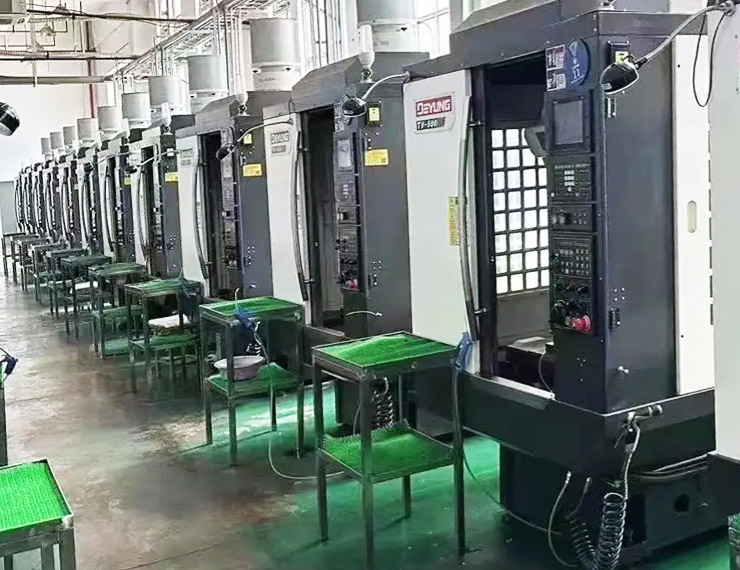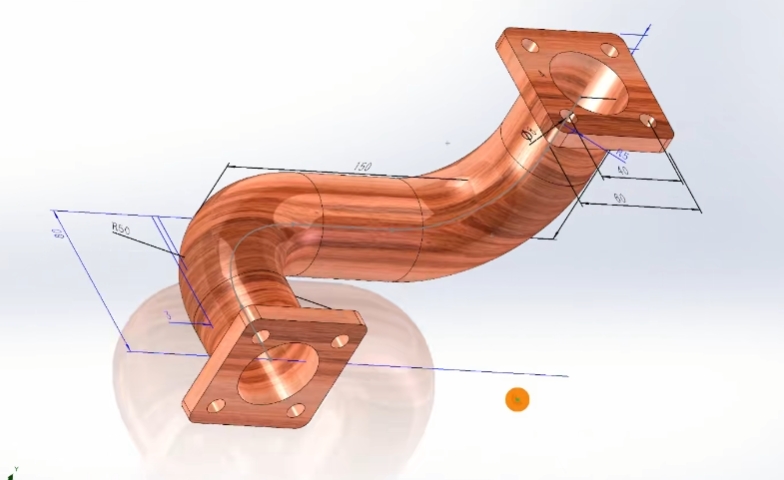Computer numerical control (CNC) is the method of overseeing a machine tool through a microcomputer connected to the device. This microcomputer carries out its tasks by interpreting a programming language known as G-code and M-code, which provides detailed directives regarding machining parameters like feed rate, spindle speed, choice of cutting tool, and the regulation of coolant flow.
Subsequently, the microcomputer transmits these instructions to the machine tool. Consequently, CNC machining obviates the need for manual intervention, rendering it well-suited for producing flawless parts, regardless of the intricacy of the product design.
What Is CNC Machining?
CNC machining is a subtractive manufacturing technique that entails the selective removal of material from a workpiece, guided by instructions sourced from a CAD model, with the aim of producing a product. This process involves machining operations like turning, drilling, or milling, and the instructions for these operations are derived from the CAD model in the form of codes (specifically, G-code and M-code), providing detailed guidance on machining parameters.
CNC machining is highly compatible with a wide range of materials, including metals, plastics, wood, and composite materials. It stands as a fundamental method for part manufacturing, often alongside additive and formative manufacturing processes like 3D printing and injection molding. Notably, CNC machining holds certain advantages over these alternative methods, such as its ability to achieve high tolerances. Let’s continue to explore these advantages further.

Main Steps For CNC Machining Process
Certainly, the CNC machining process can be simplified into five main steps:
Design and CAD Modeling
The process begins with the creation of a 3D CAD (Computer-Aided Design) model of the part to be manufactured. This digital representation serves as the blueprint for the CNC machining process, specifying the part’s geometry and features.

CNC Programming
CNC programmers develop a machining program that includes a set of instructions in the form of G-codes and M-codes. These instructions dictate the toolpaths, cutting speeds, feeds, and other parameters for the CNC machine to follow when manufacturing the part.
Machine Setup and Workpiece Preparation
The CNC machine is set up for the specific job, including loading the CNC program and configuring the machine parameters. The raw material, or workpiece, is secured within the machine, often by clamping or using workholding fixtures. Work offsets are established to define the workpiece’s position in relation to the machine’s reference point.
Machining Operations
The CNC machine executes the program, and the cutting tool precisely follows the specified toolpaths to remove material from the workpiece. This step encompasses various machining operations, such as milling, turning, drilling, or grinding, depending on the part’s design.
Quality Control and Inspection
Throughout the machining process, operators may perform quality checks to ensure the part meets specifications. Advanced CNC machines often have built-in sensors for real-time monitoring and automatic tool adjustments to maintain precision and quality.
These five steps encompass the core process of CNC machining, from design to the production of finished parts. The CNC machine’s ability to automate and execute these steps precisely and consistently is a key advantage, making CNC machining a fundamental method in modern manufacturing.
The Main CNC Machining Processes
CNC machining encompasses various processes for subtractively shaping raw materials into finished parts and components. The main CNC machining processes include:
Milling
Milling is a fundamental CNC machining process that involves the removal of material from a workpiece to create complex shapes, slots, holes, and various features. It is achieved by rotating a cutting tool (typically with multiple cutting edges) and moving it along different axes to cut into the workpiece. Milling is highly versatile and suitable for various materials, making it a common choice for producing parts with intricate geometries. CNC milling machines are indispensable for industries such as aerospace, automotive, and precision engineering.
Turning
Turning is a CNC machining process often used for creating cylindrical parts. In turning, the workpiece rotates while a single-point cutting tool is moved parallel to the workpiece’s axis. This process is excellent for producing components like shafts, rods, and bushings. CNC turning machines can achieve high precision and consistency in the production of cylindrical and conical shapes, making it an essential process for various applications.
Drilling
CNC drilling involves the creation of holes in a workpiece using a rotating drill bit or other cutting tools. It is a crucial process for manufacturing parts with precise hole locations and dimensions. CNC drilling machines can produce holes in various materials and are commonly used in industries ranging from construction to electronics. Additionally, drilling operations can include techniques like peck drilling for deep holes or counterboring for recessing the hole’s opening.
Grinding
CNC grinding is a precision machining process that achieves extremely smooth and accurate surfaces on parts. It uses an abrasive grinding wheel to remove material, resulting in very fine finishes. Grinding is vital for producing parts with tight tolerances, especially in applications where surface quality and dimensional accuracy are critical. It is frequently used in industries like aerospace, automotive, and medical devices for creating components like bearings, gears, and precision tools.
Electrical Discharge Machining (EDM)
Electrical Discharge Machining (EDM) is a unique CNC machining process that uses electrical sparks to remove material from a workpiece. It’s particularly effective for materials that are difficult to machine with conventional cutting tools, such as extremely hard metals. EDM allows for precise and intricate shapes, making it valuable in industries like aerospace and tool manufacturing. There are two primary types: Wire EDM, which uses a wire electrode, and Sinker EDM, which uses an electrode of the desired shape.
Electron Beam Machining (EBM)
Electron Beam Machining (EBM) is a CNC process that employs a focused beam of high-velocity electrons to remove material. EBM is known for its high energy and accuracy, making it suitable for cutting, welding, and drilling hard materials such as aerospace alloys and ceramics. The process occurs in a vacuum to allow the electron beam to travel unimpeded, ensuring precise material removal.
Laser Cutting
CNC Laser Cutting is a highly precise process that employs a focused laser beam to cut through various materials, including metals, plastics, and composites. The laser beam is guided by a CNC program to follow specific cutting paths. It is commonly used in industries like sheet metal fabrication, signage, and automotive manufacturing for its speed and accuracy.
Waterjet Cutting
Waterjet Cutting is a CNC machining process that uses a high-pressure stream of water mixed with abrasive materials (abrasive waterjet) to cut a wide range of materials, including metals, glass, ceramics, and composites. Waterjet cutting is highly versatile, with the ability to produce intricate shapes and is particularly popular in industries that require minimal heat-affected zones, such as aerospace and architecture.
Materials Compatible With CNC Machining
CNC machining is a versatile process capable of working with a wide range of materials, including:
Metals
Aluminum: A popular choice due to its lightweight and corrosion-resistant properties.
Steel: Including carbon steel, stainless steel, and tool steel for various industrial applications.
Brass and Copper: Often used for precision parts, electronics, and decorative elements.
Titanium: Known for its high strength-to-weight ratio and corrosion resistance.
Inconel: A superalloy used in aerospace and high-temperature applications.
Nickel Alloys: Such as Monel and Hastelloy for their corrosion resistance.
Plastics
Acrylic (PMMA): Commonly used in signage and prototyping due to its optical clarity.
ABS (Acrylonitrile Butadiene Styrene): Known for its impact resistance and durability.
Nylon: Preferred for its strength, low friction, and self-lubricating properties.
Delrin (POM): A popular choice for gears, bushings, and other mechanical components.
Polycarbonate (PC): Used for its high impact resistance and optical clarity.
PTFE (Polytetrafluoroethylene): Known for its low friction and non-stick properties.
Wood
Various types of wood, including hardwoods (e.g., oak, walnut) and softwoods (e.g., pine, cedar), are compatible with CNC machining for applications such as furniture, cabinetry, and decorative items.
Composites
Composite materials, like carbon fiber composites, fiberglass, and Kevlar, are used in aerospace, automotive, and sports equipment due to their strength-to-weight ratio.
Ceramics
Ceramics, such as alumina and zirconia, are used for their wear resistance and high-temperature capabilities in applications like cutting tools and medical devices.
Foam Materials
Materials like foam boards and expanded polystyrene (EPS) are commonly machined for packaging, signage, and architectural models.
Rubber and Elastomers
Materials like rubber and silicone can be machined for gaskets, seals, and various industrial applications.
Glass
CNC machining can be used for precision glass cutting and engraving for applications like optics and displays.
Stone
CNC machining can shape and engrave natural and engineered stones for architectural elements, monuments, and artistic purposes.
Exotic Materials
Specialized materials like molybdenum, tungsten, and various engineering plastics can also be machined for specific applications.
Benefits Of CNC Machining
CNC machining, short for Computer Numerical Control machining, offers a multitude of benefits that have made it a cornerstone of modern manufacturing. Here are some key advantages of CNC machining:
Precision and Accuracy
CNC machines excel at producing parts with exceptional precision and accuracy. They can consistently achieve tight tolerances, ensuring that each part meets the desired specifications. This level of precision is crucial in industries where exact measurements are essential, such as aerospace and medical device manufacturing.
High Efficiency
CNC machining is a highly efficient process. Once a program is set up, the machine can run continuously and with minimal human intervention. This results in increased productivity and reduced production times, ultimately saving time and costs.
Versatility
CNC machines are exceptionally versatile. They can work with a wide range of materials, including metals, plastics, wood, composites, ceramics, and more. Furthermore, they can perform various machining operations, such as milling, turning, drilling, and grinding. This adaptability makes CNC machining suitable for a wide array of applications and industries.
Complex Geometries
One of the standout advantages of CNC machining is its ability to manufacture parts with intricate and complex geometries. This includes the production of components with intricate curves, angles, and fine details that may be challenging or impossible to achieve with manual machining processes.
The Future of CNC Machining
The future of CNC machining holds exciting developments that continue to shape the manufacturing landscape. Some key trends and advancements include:
Automation and Industry 4.0 Integration
The integration of CNC machines with Industry 4.0 principles is transforming manufacturing. Smart CNC systems are now equipped with sensors and IoT (Internet of Things) connectivity, enabling real-time data collection and analysis. This data helps optimize processes, reduce downtime, and improve predictive maintenance.
AI and Machine Learning
Artificial intelligence and machine learning algorithms are enhancing CNC machining by improving toolpath optimization, predicting maintenance needs, and ensuring quality control. These technologies are becoming integral for enhancing efficiency and precision.
Advanced Materials
The development of new materials, including advanced composites, superalloys, and high-performance plastics, is challenging CNC machining to adapt. CNC machines need to be capable of handling these materials and, in some cases, employ specialized tooling and cutting strategies.
Miniaturization and Micro-Machining
The demand for smaller and more intricate components, particularly in electronics and medical devices, is driving advancements in micro-machining. CNC machines are evolving to meet the requirements of this niche, focusing on precision and reduced heat generation.
Remote Monitoring and Control
With the rise of remote work and the need for real-time oversight, CNC machines are increasingly equipped with remote monitoring and control capabilities. This enables operators to manage CNC machining processes from anywhere in the world, enhancing operational flexibility.
3D Printing-Integrated CNC Machines
Hybrid machines that combine CNC machining with 3D printing are on the horizon. These machines can fabricate complex parts with a combination of additive and subtractive processes, reducing the need for multiple setups and tool changes.
